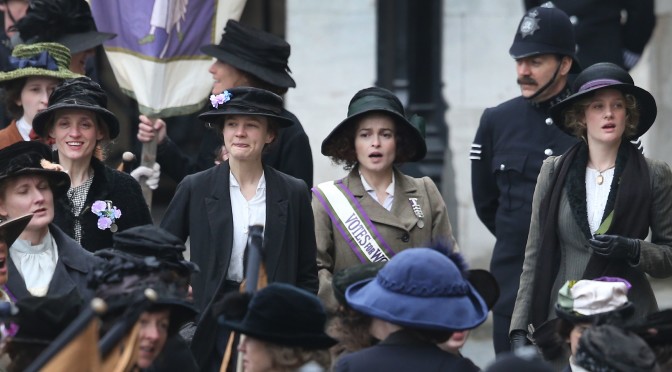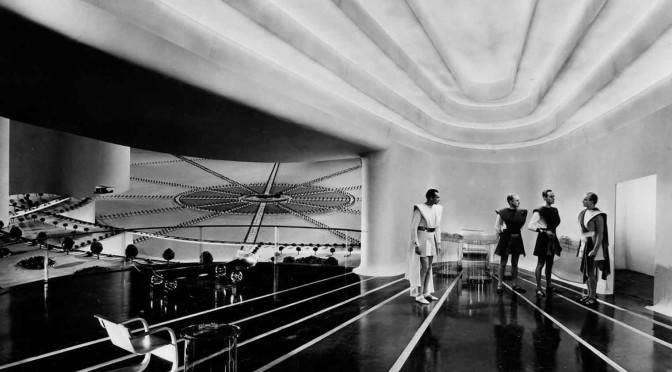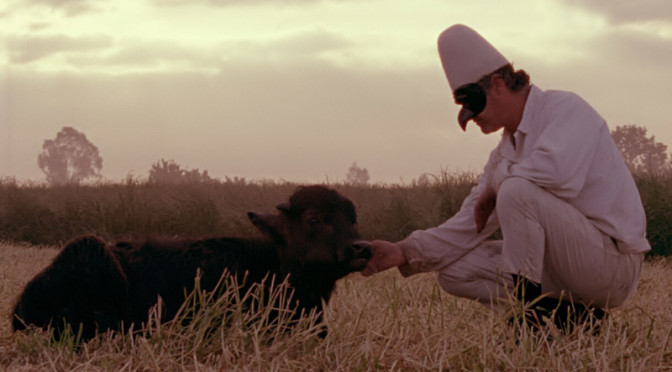Mauro Herce, di origine catalana, al suo debutto da regista ci propone Dead Slow Ahead, un lungometraggio che – è stato detto in sede di proiezione, con il regista presente – è stato “conteso” fino all’ultimo tra la sezione “Cose che verrano” per il suo carattere fantascientifico e la sezione Tffdoc che infine è riuscita ad aggiudicarselo. Continua la lettura di “Dead Slow Ahead” di Mauro Herce
Archivi tag: TFF33
“Suffragette” di Sarah Gravon – Conferenza stampa
Se ieri sera la proiezione del film Suffragette ha inaugurato il 33° TFF, stamattina la prima conferenza stampa dell’edizione 2015 ha visto protagonista lo stesso film. A rispondere alle domande dei giornalisti erano presenti la regista Sarah Gravon, la sceneggiatrice Abi Morgan, e una delle due produttrici, Faye Ward.
Continua la lettura di “Suffragette” di Sarah Gravon – Conferenza stampa
The Press conference: Suffragette Opens 33 TFF Press Conference
Article by: Danila Prestifilippo Translation by: Roberto Gelli
Not only was Suffragette shown yesterday evening to inaugurate 33th TFF, but also the film was the protagonist of the first press conference, which took place this morning. Film director Sarah Gavron, screenwriter Abi Morgan and one of its producers Faye Ward answered journalists’ questions and explained the film goals and the choices they made, in order to create the short film.
Muad (Carey Mulligan), a female worker, is the protagonist. She is a fictional character and fights together with other women, who represent really existed historical feminists like Emmeline Pankhurst (Merylin Streep). As director Gavron pointed out, the aim of this semihistorical approach was to make a connection between the women, who were given the mocking name Suffragettes and started their battle for their right to vote hundred years ago and modern women, who are still struggling with salary discrepancy, sexual violence and for their right to children protection and tutoring.
Suffragettes social movement has fought for fifty years but, if it is true that the first forty years had been a pacific struggle, in the following sixteen months the fight became more violent and cruel and almost none knows about it. The absence of films that tell us about the violence these courageous women had to endure, played a great role in persuading Faya Ward and Alison Owen to produce the film. Faya Ward stated: “We wanted the public to be aware of the importance of the sacrifices and the success related to Suffragettes fight. We also wanted to underline how their results are effective in nowadays society. We have tried to give modern spectators some contact points, in order for women not only to be politically active, but also to encourage them to be and become what they really feel they are or they could be. Our attempt was to give voice to those, who were not yet given their chance on the big screen.”
Abi Morgan, who had already been the screenwriter of movies such as The Iron Lady, emphasized that the challenge was to choose a really meaningful example of woman’s life and be able to put it in a precise historical context. She said: “On the one hand the character of Muad underlines the role of lots of passive supporters who became activists, on the other hand it investigates the reasons which persuaded women like her to put their jobs, their families and their homes at risk, in the name of a civil right”. The film focuses on the political matter and puts in the foreground these courageous protagonists, so the decision to not examine in depth personal stories was due to the fact that there are not enough literary or movie material at disposal, to which one can refer to. With reference to that, Morgan added that it was much more important to end the film with information about Saudi Arabia and its 2015 law concerning women right to vote only if accompanied by men, rather than to think at some sort of dramatization of Maud in the Hollywood style.
Sarah Gavron gave some further meaningful figures: “Still today, 66 million of women worldwide have no right to vote, 2/3 are illiterate and only 22% hold public offices. It says that the face of poverty is female and unfortunately these figures confirm it”.
The film’s aim is not only political and historical, it concerns the social matter too by denouncing and preventing the high young people abstaining rate, above all among women. Director Gavron told about the reaction of most of the female audience attending Suffragette’s introduction meetings. As she had hoped, after seeing the film, they expressed their wish to vote again because it made them aware of the sacrifices made by British feminist movement. She also reported that the troupe film (almost completely composed by women) wanted to give a clear signal during the film shooting, so they symbolically demonstrated against government by obtaining the permission to film in the House of Parliament in London, that same institutional place, which had declared against women right to vote.
Asked about a possible way to increase female presence in all sectors, starting from institutional offices, Abi Morgan answered: “We have to introduce the concept of positive discrimination and keep insisting about the importance women have within a context implying equality of the sexes. Geena Daves said “See in order to Be”: we need to have a radical attitude, to leverage the mass media but, in order to be successful, women complicity is essential”.
Faye Ward ended the press conference by making a consideration about the fact that Suffragette is a film of women who fight for their right to vote but “today the concept of fight may imply different ways. Each one of us can be what he wants to be, and this is true for both genders and all races. It is enough that we find our own voice and utter our words in every place, in political institutions or other kind of institutions.
“Things to Come” (“La vita futura”) di William Cameron Menzies
Nell’immaginaria città anglosassone Everytown è in corso la seconda guerra mondiale: guerra iniziata nel 1940 e che proseguirà fino al 2040. Questa è la ragione per cui i cittadini stessi, nipoti e i bisnipoti, non si ricordano nemmeno i motivi per i quali tale guerra fosse iniziata. Il film Things to Come è stato diretto da William Menzies, uno dei maggiori scenografi della storia del cinema, che crea un gioco visivo tra utopia e distopia.
Continua la lettura di “Things to Come” (“La vita futura”) di William Cameron Menzies
“Mia madre fa l’attrice” di Mario Balsamo
Mario Balsamo, dopo il successo di Noi non siamo come James Bond, vincitore del premio della giuria al TFF30, ritorna sulla scena torinese con un altro spaccato della sua vita: il documentario Mia madre fa l’attrice, uno dei quattro film italiani in concorso quest’anno al Torino Film Festival. Continua la lettura di “Mia madre fa l’attrice” di Mario Balsamo
Mia madre fa l’attrice by Mario Balsamo
Article by: Lara Vallino Translation by: Andrea Cristallini
MIA MADRE FA L’ATTRICE
Documentaries have often been overlooked or dimissed as not suitable for cinema screenings on the grounds that they are too specialized, although they bring to the big screen unknown or intentionally ignored realities. Conversely, after his succesful Noi non siamo come James Bond, which gained him the Jury Prize at TFF 30, Mario Balsamo makes his comeback in Turin with another slice of his life: the documentary Mia madre fa l’attrice, one of the four Italian movies in the main section of the festival.
No polar bears or exotic indigenous peoples then, here we are in fact presented with a typical emotional connection, the one between a mother and her son. Since the dawn of times, this indissoluble bond has always been subject to study, and this is still the case today. Either audiences are not tired of listening to the same old story, or perhaps a universally accepted definition has not been agreed upon yet.
Mario Balsamo shows us the very self of his mother: a tough character, a troublesome person, the woman he loved most in his life. He also reveals the difficulties in their relationship: they seem to have become more distant than ever, separated by a wall of mutual incomprehension.
However, sometimes something happens that teaches us how to look at life from a new perspective and after the events he related in his documentary in 2012, Mario is not the same man anymore. He wants to reconnect with the multifaceted woman and be finally able to love her not just as an actress but also as his mother. He takes the most important film in which his mother acted in the 1950s, Piero Costa’s La Barriera della legge, as an opportunity to get close to her again through their shared passion for the film art. Costa’s film is a constant remembrance for Silvana and an obsession for Mario, although neither of them has ever seen it.
They embark on the search for this cinematographic work, that appeared to be no longer available and that they will eventually find uninteresting once they get to see it.
But it’s a well-known fact that it’s the journey that counts. They go on the road in a Lancia Fulvia 810, around Pietrasanta and Versilia, visiting the very same places where Silvana would display her talent many years ago. We witness amusing and moving dialogues, halfway between reality and fantasy, gradually leading to a reconciliation which results in a long-awaited hug. A happy ending for the director, who may finally manage to see in Silvana Stefanini a mother, rather than just an actress.
Lost and Beauty: the Dying Italy
Article by: Alessandro Arpa Translation by: Chiara Toscan
TF<<Chi la ridusse a tale? E questo è peggio,
Che di catene ha carche ambe le braccia;
Sì che sparte le chiome e senza velo
Siede in terra negletta e sconsolata,
Nascondendo la faccia
Tra le ginocchia, e piange.
Piangi, che ben hai donde, Italia mia…>>.
After 27th edition’s winning film La bocca del lupo (The Wolf’s Mouth) TFF dedicated the pre-opening night to the latest laborious work by Pietro Marcello, Bella e perduta (Lost and Beautiful), the only Italian film contending for Locarno International film festival 2015. This bitter tale fuses documentary and fantastical fiction, while poetically denouncing the collapse of human-nature relationship. The film also functions as an off-key requiem for the Italian Republic, a frank protest against the apathy of an immortal caste system of defeatists. The protagonist, Tommaso Cestrone, is a humble, real-life shepherd in line with Marcello’s stock characters, the so renamed “Angel of Carditello” is the only volunteer serving the Royal Estate of Carditello which simbolises the ill-treated and forgotten beauty. Piles of debris and tyres pollute the magic atmosphere of the place that has become a dump for memories. Tommaso is the only one committed to the enhancement from the indifference of the world. Tommaso, among his last wishes, wants to save Sarchiapone, a young talking buffalo that, at times, recalls the melancholy poetry hidden in Balthazar, the donkey protagonist of Au Hasard Balthazar by Robert Bresson. At this stage of the film, Pulcinella appears from the obscure bowels of Vesuvius. He arrives in the nowadays Campania to grant Tommaso’s wish. Pulcinella and Sarchiapone embark on a journey in the forgotten territories of “the land of fire”: a sore journey without hope. Bella e Perduta is a protean film that had a difficult birth. The initial intention of the director was changed during the course of production due to the sudden cardiac death of the real Tommaso Cestrone. For this reason, the film was completed after two years of development. The only choice left to the director was to merge the hints of reality with dreamlike situations. The figure of Pulcinella connects the primordial meaning of psychopomp very intelligently for the immortals. Although the protagonists improvise around a default scenerio, it is difficult to reach the sincere expressive power of transexual Mary Monaco and Enzo Motta, who are the protagonists of “La Bocca del Lupo”. Tommaso and the interpreter of Pulcinella are suspended and suddenly crushed by the power of nature, mother and executioner at the same time. The foolishness of human being is expressed by the look and subjective shots of Sarchiapone who hopes to survive at the mercy of man. But now eveything is destined to collapse and takes attention to the tomb of Tommaso: <<Will we remember this land? >>
Probably not. Maybe yes but it will be very late, and there will remain neither your tears Sarchiapone… nor ours.
“Bella e perduta” di Pietro Marcello
<<Chi la ridusse a tale? E questo è peggio,/ Che di catene ha carche ambe le braccia; / Sì che sparte le chiome e senza velo / Siede in terra negletta e sconsolata, / Nascondendo la faccia / Tra le ginocchia, e piange. / Piangi, che ben hai donde, Italia mia…>>.
Dopo La bocca del lupo, vincitore della 27a edizione del Torino Film Festival, il Tff dedica la serata di pre-apertura al nuovo travagliato lavoro di Pietro Marcello intitolato Bella e perduta. Unico film italiano in concorso al Festival Internazionale del Film Locarno 2015, Bella e perduta è una docu-fiaba amara, una denuncia poetica del collasso tra natura e uomo. Ma è anche un requiem stonato per la Repubblica italiana, un candido urlo contro gli indifferenti, casta immortale di disfattisti.





